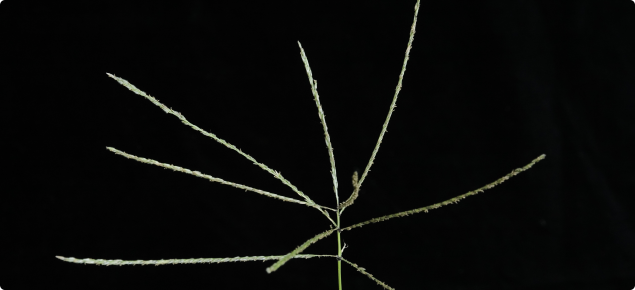Features
Digit grass has the following features:
- a persistent, drought-tolerant, tufted grass
- adapted to a wide range of soils
- good drought and cold tolerance
- tolerates heavy grazing once established
- low tolerance of waterlogging.
Digit grass (Digitaria eriantha) is an out-crossing species native to South Africa (Transvaal, Orange Free State, northern Cape) where it occurs in a range of habitats in summer-rainfall areas (400–1000mm). It is cultivated in South Africa, Argentina and Australia. This species also includes Pangola grass (Digitaria eriantha ssp. pentzii, formerly D. decumbens) which must be vegetatively planted and is widely grown in tropical regions (not discussed here).
Digit grass is a species which has not been widely sown in WA, but in field trials the persistence and production has been lower than panic grass and Rhodes grass. In NSW, digit grass has persisted and performed well on a wide range of soils and environments. It has survived severe droughts and persisted in the long-term under commercial grazing.
Description
The morphology of digit grass can be described as:
- a medium to tall (60–130cm), tufted grass
- the lowest leaf sheaths are densely hairy, but the leaves have few or no hairs
- stems are usually unbranched and up to 130cm high
- finger-like seed head with one to three whorls arranged on a central axis.
Seasonal growth pattern
Digit grass grows actively after the first rains until late autumn and from early spring. It will grow opportunistically over summer if moisture is available. In WA, digit grass has negligible to low growth in winter, but in Queensland it is reported to have some winter activity. Cool season growth (April-September) of premier digit grass was similar to kikuyu in south-east Queensland.
| Rainfall (estimated minimum) | >450mm (south coast >400mm) |
|---|---|
| Drought tolerance | Moderate to high |
| Frost tolerance | Low to moderate - it is used in South Africa as ‘foggage’ (that is, standing frosted hay) |
| Soil type | Grows on a range of soils from acid sands to clay soils, but less suited to deep pale sands |
| Soil fertility requirements | Responsive to nitrogen fertiliser. Persists on low fertility soils, but production will be low |
| Soil pHCa | >4.2 (estimated) |
| Aluminium tolerance | Moderate to high |
| Waterlogging tolerance | Low |
| Salt tolerance | Nil |
| Ability to spread naturally | Low |
| Nutritive value: dry matter digestibility | 64% (regular cutting), 51% (feed deferred to winter) |
| Nutritive value: crude protein | 12.1% (regular cutting), 5.0% (feed deferred to winter) |
Establishment
Digit grass has a small, slightly hairy seed (3.3 million/kg), which may require a carrier to improve flow and ensure even seed distribution when sowing. Alternatively use coated seed. The suggested sowing rate is 1–2kg/ha of good quality (uncoated) seed when sown alone. Check the seed purity as many lines are contaminated with Rhodes grass. Digit grass should be sown at a depth of 5–10mm with good seed to soil contact. Seedlings can be slow to establish and are sensitive to moisture stress over the first summer.
Livestock disorders
No livestock disorders reported. It has a low soluble oxalate content.
Management
Digit grass can withstand heavy grazing for short periods (7–40 days), which should be followed by a rest period to allow the root reserves to be replenished and the opportunity to occasionally re-seed. Standing feed is still palatable after frosting and green shoots may be found near the ground.
Digit grass tolerates fire, has good insect resistance and is generally disease-free, but the seed heads can be infected by a false smut (Ephelis sp.) under humid conditions.
Companion species
Digit grass is suitable for growing with a range of annual legumes. In NSW it is grown with Rhodes grass, Consol lovegrass and lucerne on coarse-textured, mildly acidic soils.
Cultivars
Two varieties of digit grass, Premier and Apollo, have been released in Australia.
Premier (public variety) was the first digit grass cultivar released in Australia. It has shown good persistence and production on a range of soils in Queensland.
Apollo (public variety) was selected for superior spring growth, but had inferior seed production to Premier and has not persisted in commerce.



